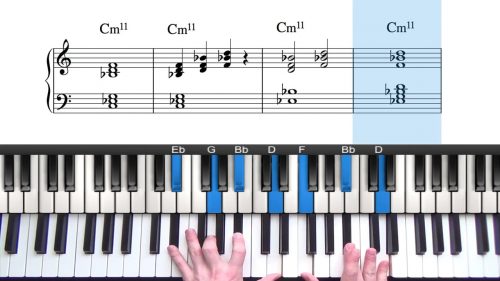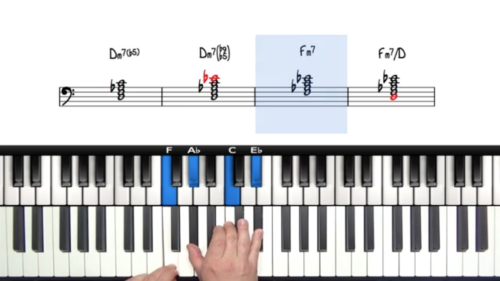Targeting The b9 With Inner Voices
In this lesson we learn how to target the b9 chord alteration over the V7 with a descending inner voice.
We start by applying this technique to 3 jazz standards so that you can see how it is applied in practice. We then explore the movement over a 251 in the key of C Major, and finally we take this drill around the whole step 251 sequence.
Visualising The b9 Alteration
The main benefits of mastering this exercise is that you will be able to visualise the b9 chord alteration in all 12 keys. When playing jazz standards and filling space in tunes, the b9 is a lovely tone to target to add colour and tension.
The Next Steps
In the next lessons we will repeat the same process with the other chord alterations which are the #9, #11, and #5/b13.
Once we can clearly visualise these alterations in all 12 keys and approach them chromatically or via inner voice movement, we have unlocked one of the many secrets to professional and sophisticated sounding jazz piano performance.
Lesson Downloads
-
Targeting The b9 – Whole Step 251s File Type: pdf
Practice Tips
-
The preliminary exercise for this lesson is the 13b9 whole step drill where we drop the 2 middle voices in an extended 251 to access the 13b9 colour over the dominant V7 chord.
-
The main variation in this lesson is that we add the descending inner voice which targets the b9. We must visualise this inner voice starting on the b7 of the ii-7 chord, and ending on the b9 of the V7 chord.
-
Once you have mastered the basic inner voice experiment with repeating the b9 an octave higher to draw more attention and emphasis to the sound of the alteration.








Hi Hayden, in a few of your lessons, I noticed you mentioned different modes of scales. I am actually not familiar with different types of scales as I was classically trained so I only knew about major, melodic and harmonic minors. Would you mind to recommend which lessons/tutorial I can refer to, regarding the scales of jazz music? Thanks!!
Hi Erica,
Yes sure.
An important relationship to understand is that we can turn any major scale into the ‘mixolydian mode’ by dropping the 7th note by half a step. The mixolydian mode is the scale that fits with a regular dominant chord without alterations.
We create alterations by raising or lowered the upper extensions of the chord, the upper extensions of the chord are 9, 11, and 13. So there are 3 possible extensions (9/11/13) and only 4 possible alterations are b9, #9, #11, and b13 (the b13 can also be referred to as the #5)
Perhaps the most useful scale to understand in relation to this lesson is the ‘altered mode’, you can find 2 lessons on that topic here where we delve deeper into where these alterations come from and how they are constructed from the mixolydian mode:
pianogroove.com/jazz-piano-lessons/altered-scale-improv/
pianogroove.com/jazz-piano-lessons/hearing-resolving-altered-tensions/
We also discuss chord alterations in great detail in the course on altered harmony:
pianogroove.com/jazz-piano-lessons/altered-harmony-upper-structure-triads/
I recommend to study this after the course on chord extensions.
Instead of jumping around topics, I think it’s important that you can clearly visualise the milestones ahead of you.
In the 2 seminars below I explain the main theory milestones for beginner/early intermediate jazz students, and specifically which courses to study and the most important drills:
Voicings For Beginners & Beyond
pianogroove.com/live-seminars/jazz-voicings-for-beginners/ – see the “Beginner Jazz Roadmap PDF” in the resources section of this seminar which links to the exact drills which you need to master to progress onto the next course)
Essential Chord Progressions
pianogroove.com/live-seminars/chord-progressions-for-beginners/ – this seminar follows a similar format but focusing on chord progressions.
These seminars are around 1 hour each, but they will allow you to see how we start with the foundations, then add chord extensions, then rootless voicings, and then altered harmony. These 4 courses are, in my opinion, the most important topics for beginner/early-intermediate jazz studies.
I hope that helps Erica, and please let me know if you have any further questions.
Talk soon,
Hayden